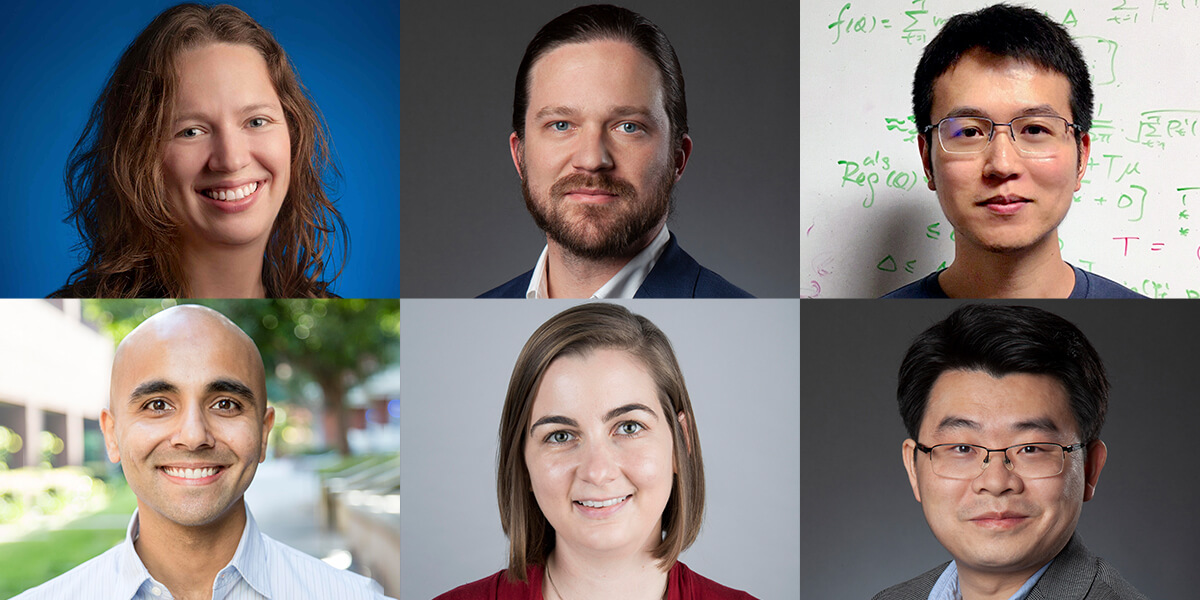
Top left – right: Aleksandra Korolova, Daniel McCurry, Haipeng Luo. Bottom left – right: Mitul Luhar, Megan McCain and Qiming Wang.
A record six assistant professors at the USC Viterbi School of Engineering — Megan McCain, Department of Biomedical Engineering; Mitul Luhar, Department of Aerospace and Mechanical Engienering; Aleksandra Korolova and Haipeng Luo, Department of Computer Science; and Daniel McCurry and Qiming Wang, Sonny Astani Department of Civil and Environmental Engineering — have received the prestigious National Science Foundation CAREER Award for innovative and novel research in their respective fields.
Megan McCain
Megan McCain, Chonette Early Career Chair and assistant professor of biomedical engineering, stem cell biology and regenerative medicine, conducts research in the area of cellular systems and molecular bioengineering.
McCain’s new NSF CAREER Award will study the uterus and how its smooth muscle cells respond and adapt to mechanical forces.
The uterus is a muscular organ that undergoes significant mechanical deformation during pregnancy. It is also highly susceptible to fibroids, which are rigid masses that cause pain and discomfort. Fibroids, and other common uterine disorders, change the mechanical load on the uterine smooth muscle cells, located in the wall of the uterus.
Said McCain: “Most uterine disorders and pregnancy complications, such as preterm labor, have relatively few treatment options, largely because the uterus has been underrepresented in biomedical research.”
“Thus, the goal of my project is to establish a fundamental understanding of how the activity and strength of muscle cells in the uterus is affected by different types of mechanical stimulation,” she said.
McCain said that during pregnancy, uterine smooth muscle cells are stretched by the growing fetus but remain in a dormant state until the fetus reaches term, at which point they rapidly become contractile. If this transition occurs too early, this can result in preterm labor and birth, which is the leading cause of neonatal death in the U.S.
“It is difficult to predict or prevent in large part because the biomechanical and biochemical stimuli that trigger uterine contractions are poorly understood,” McCain said.
The research goal of this project is to measure how the contractility of uterine smooth muscle cells is affected by tissue stiffening and stretch.
The project will also include an educational outreach component, developing a series of interactive hands-on activities for high school students about muscle mechanobiology and tissue engineering. These activities will be developed in partnership with undergraduate student volunteers, executed at a local high school in urban Los Angeles and broadly disseminated.
Aleksandra Korolova
Aleksandra Korolova, a WiSE Gabilan Assistant Professor of Computer Science, aims to develop algorithms and technologies that enable technological innovation, while preserving privacy and fairness. Recently, her research has focused on how targeted advertising can create concerns related to privacy, manipulation of vulnerable people and discrimination.
Korolova’s new NSF Career Award, titled “Towards Privacy and Fairness in Multi-Sided Platforms,” specifically explores the algorithmic and privacy practices of multi-sided online platforms such as Google, Facebook, YouTube and LinkedIn. A multi-sided platform is a service, technology or product that lets two or more customer or participant groups have direct interactions.
The project aims to identify and mitigate undesirable societal outcomes, such as unfairness or discrimination, that can arise as a result of multi-sided optimization algorithms run by platforms pursuing objectives driven by financial growth and user engagement.
For instance, Korolova’s research has demonstrated that Facebook ad delivery can lead to skewed outcomes along gender and racial lines for employment and housing opportunities. In relation to political advertising, Korolova and her research colleagues also found that Facebook’s algorithms make it more expensive for a political campaign to get its message to users across party lines, potentially driving polarization.
She also aims to enable deployment of a rigorous notion of privacy—differential privacy—for data sharing in platform-specific contexts. An algorithm is differentially private if an observer seeing its output cannot tell if a particular individual’s information was used in the computation.
“Our lives and society are increasingly mediated by machine learning algorithms selected and run by online platforms using private data,” said Korolova. “Scientific research can benefit individuals and society by helping us understand the risks posed by these algorithms, and propose approaches to enable data-driven innovation while still preserving privacy and fairness.”
Daniel McCurry
McCurry, an assistant professor of civil and environmental engineering, focuses on protecting public health by improving the long-term safety of engineered water sources, namely recycled wastewater.
The issue, he says, is that certain wastewater treatment methods interact with chemicals in wastewater to create harmful byproducts. For example, processes such as ozonation, adding the chemical compound ozone, to disinfect wastewater can create nitromethane. To make wastewater potable, one of the final steps is adding chlorine, which, when interacting with nitromethane, can result in the formation of chloropicrin, a toxic chemical used to deter enemy soldiers during World War I.
With funding from the NSF CAREER Award, McCurry and his team are looking deeper into identifying which specific chemical precursors are responsible for formation of certain harmful byproducts during wastewater treatment.
Said McCurry: “If we know what those precursors are and we understand their formation chemistry toward the toxic byproducts, then maybe we can change something about the treatment process to remove the precursors.”
McCurry noted that while this is not a new field of research, progress has been generally slow. “Most of the work that’s been done in this area has been in the context of drinking water treatment of surface waters like rivers or lakes. In drinking water treatment, the background natural organic matter that reacts with chlorine or whichever disinfectant is used to form byproducts is very complicated and highly heterogeneous (composed of many different components),” McCurry said. Thus, we can’t say exactly what natural organic matter is, he said, because it’s like snowflakes — every molecule is different.
Unlike traditional drinking water treatment, in which disinfectants react largely with natural organic matter, created mainly from various decayed vegetation like plants and bark, wastewater can contain additional contaminants either directly dumped into the water or excreted into it, for example pharmaceuticals and recreational drugs.
“My overall vision for this project is that in recycled wastewater identifying harmful byproduct precursors will be easier.” He says this is because all wastewater used to be tap water; all the natural organic matter was already oxidized and depleted on its last pass through the urban water cycle. So the question that remains is then, “What else is left to react with?”
McCurry says there are two main precursor sources left: chemicals we put into the system, either chemicals that we flush down the toilet or things that are excreted, and the bacteria used in the wastewater treatment process. Narrowing it down to these categories, McCurry says, makes identifying the chemical source material for certain byproducts that much easier. Using a series of samples and experiments, coupled with database searches to find chemical compounds containing a particular chemical group and a particular set of characteristics (hydrophilic, non-biodegradable), McCurry and his research team hope to identify harmful precursors, so they can be removed from the treatment process.
“This is a timely issue in Southern California, given concerns over water supply,” McCurry said. “It’s long been a vexing problem without a satisfying solution, but we hope to find a clearer answer by looking deeper into wastewater specifically.”
Haipeng Luo
With algorithms increasingly running our lives, it’s important to accurately analyze them to discover which is most effective. Perhaps you’re interested in the speed of an algorithm or the solution quality of a difficult problem. You’re looking for a mathematical way to say one algorithm is better than another. But how is this determined?
This is one of the fundamental challenges in machine learning, which is being tackled by Luo, a USC Viterbi assistant professor of computer science. Luo is recognized for developing more adaptive and efficient machine learning algorithms with strong theoretical guarantees. His recent research focuses on developing efficient, adaptive, and robust algorithms that enable machine learning to function with partial information.
Specifically, Luo’s new NSF CAREER Award will support his research titled, “Learning with Limited Feedback – Beyond Worst-case Optimality.” Worst-case analysis is the dominant paradigm for making algorithm comparisons: the overall performance of an algorithm is summarized by its worst performance on any input of a given size.
But in more sophisticated applications, you begin to see the drawbacks of this worst-case approach, which can give misleading or incorrect guidance about which algorithm to use to solve various problems.
And, because we use algorithms to make important decisions on our behalf, it’s more important than ever to have a deep mathematical understanding of when algorithms work and when they don’t.
“Traditional machine learning methods work by first collecting data and then training a fixed model for future predictions,” said Luo.
“However, much more challenging scenarios emerge as machine learning is deployed in more sophisticated applications, especially those that interact with humans or other agents, such as recommender systems, game playing agents, self-driving cars and many more.”
In these applications, the learning agent — a tool in AI that is capable of learning from its experiences — must work reliably with limited feedback from the surrounding environment. For example, a self-driving car only observes the impact of the actions it has taken. But, to plan reliably for the future, it must learn to reason about outcomes if different actions were taken.
“The success of this project requires developing new algorithmic techniques and mathematical tools in a variety of disciplines, including computer science, information theory, optimization, statistics, control theory, and their combinations in an innovative way,” said Luo.
Mitul Luhar
Luhar, the Henry Salvatori Early Career Chair and assistant professor in aerospace and mechanical engineering, focuses on two major themes in his research: the interaction between turbulent flows and complex (rough, porous) surfaces and the interaction between turbulent flows and flexible structures. These areas have applications to aerodynamic and hydrodynamic design, with an aim toward making vehicles moving through the air or water more efficient.
His most recent project, funded by the NSF CAREER Award, deals with porous cellular materials — materials which have repeating structures that self-tesselate to fill space. The microstructure of such materials plays a big role in dictating their physical properties, such as high strength, low density and stiffness. For years, scientists have extrapolated this concept to develop materials that are strong, as well as lightweight. Now, Luhar and his research team are looking at porous cellular materials for another purpose: to control fluid flow.
A primary focus of this research will be to develop scientific tools to help design cellular materials for flow control. Development of porous cellular materials has the potential to reduce “noise,” disruptions caused by turbulent fluctuation in pressure, and decrease drag, a force that opposes forward motion that can be created by friction between the water and the surface of the vehicle flowing through it. These materials can also help regulate heat transfer.
Said Luhar: “Since porous, cellular materials allow fluid to pass through, we can, in principle, design the cell structure to regulate the fluid flow in clever ways. The project will broadly build upon this idea, with the goal of controlling fully turbulent flows. This could result in significant performance improvements for aircrafts, water vessels and ground vehicles.”
Turbulence, characterized by chaotic changes in pressure and flow velocity, is an essential factor considered when designing airplanes, ship hulls, pipelines and more. The project builds on preliminary evidence that anisotropic porous materials — materials that let fluid pass through much more easily in one direction compared to the other two — have the potential to reduce fluid friction in turbulent flows.
In preparation for this project, Luhar and his team of researchers have developed computational models to predict the effect of different types of porous materials on turbulent flows. They have designed and fabricated cellular materials to test and conducted several proof-of-concept laboratory tests. The next step, Luhar noted, is to increase the scope and depth of these efforts.
“We need to test and verify our computational models further and push the boundaries of what is manufacturable in terms of cellular materials. Once we have more confidence in both these areas, we will iterate on laboratory tests,” Luhar said.
The computational models the team has developed will help optimize properties such a porosity and permeability to reduce friction and suppress near-wall turbulence. These results will then be used to design and 3D-print cellular materials exhibiting specific properties identified by the models, bridging the gap between what’s theoretically possible and what can actually be created on a large scale.
Qiming Wang
Wang, the Stephen Schrank Early Career Chair and assistant professor in civil and environmental engineering, has dedicated his career to studying civil engineering challenges through the lens of material resilience and reusability. Wang and his research team are particularly interested in stimuli-responsive materials, self-healing materials, acoustic metamaterials, and engineered living materials. They also focus on additive manufacturing of new bioinspired materials to help in creating lightweight and reconfigurable, and thus multi-use, structures.
With his new NSF CAREER Award, Wang will study the fundamental mechanics of a new material that can not only change color upon deformation, but also self-repair cracks. With years of expertise on self-healing materials, Wang and his team are expanding the abilities of their self-healing material to include a color-changing system to indicate cracks and damages, thus alerting engineers to a potential issue.
Said Wang: “The new material nicely integrates two capabilities: self-sensing of damages and self-healing of damages.”
The new material with embedded dynamic chemicals can instantaneously change color when deformed or fractured and autonomously self-heal fractures. Studying the mechanics of this new material may potentially make a huge impact in designing future resilient structures that can self-sense damages induced by fatigue or external hazards or attacks, and then self-heal these damages to fully restore the structural performance. This builds on Wang’s recent research, which demonstrates a new material capable of shape restoration and self-healing, through the remote application of heat.
One of 14 grand engineering challenges in the 21st century, announced by the United States National Academy of Engineering, is to restore and improve urban infrastructure. Wang said the rapid population growth in our modern society requires a considerable amount of money to continuously repair and replace aging infrastructure.
“The pressures from the unpredictable hazards such as hurricanes, earthquakes, and terrorist attacks also pose an acute demand for resilient infrastructure,” Wang said. Inspired by nature, Wang’s research goal is to design resilient living structures by integrating living components (dynamic chemicals or living cells) into structural systems with the aid of the emerging additive manufacturing technology.
“The long-term vision is that these living structures can serve as the next-generation resilient infrastructure that behaves like the biological structures to autonomously grow, remodel, strengthen, and heal in response to the aging, fatigues, natural hazards, and terrorist attacks,” Wang said.
Published on June 1st, 2020
Last updated on May 16th, 2024











